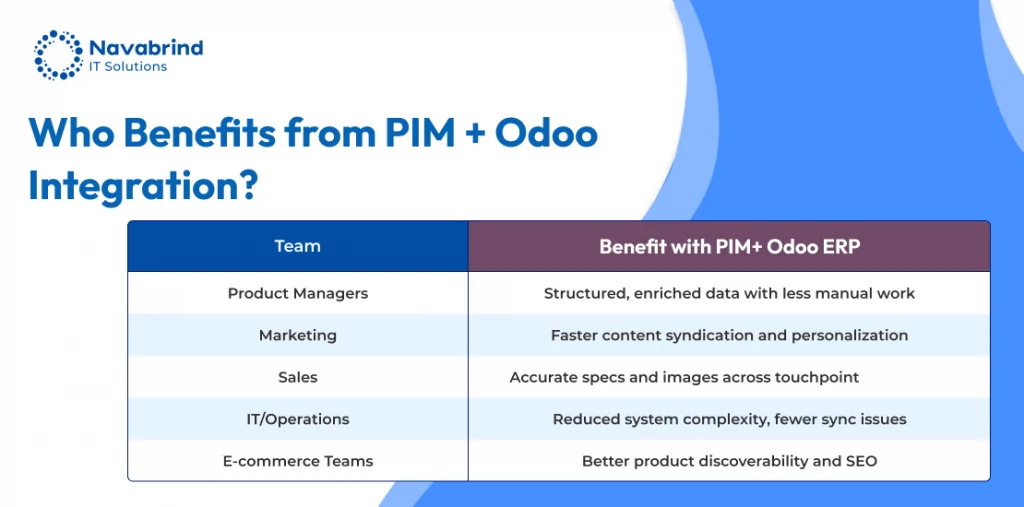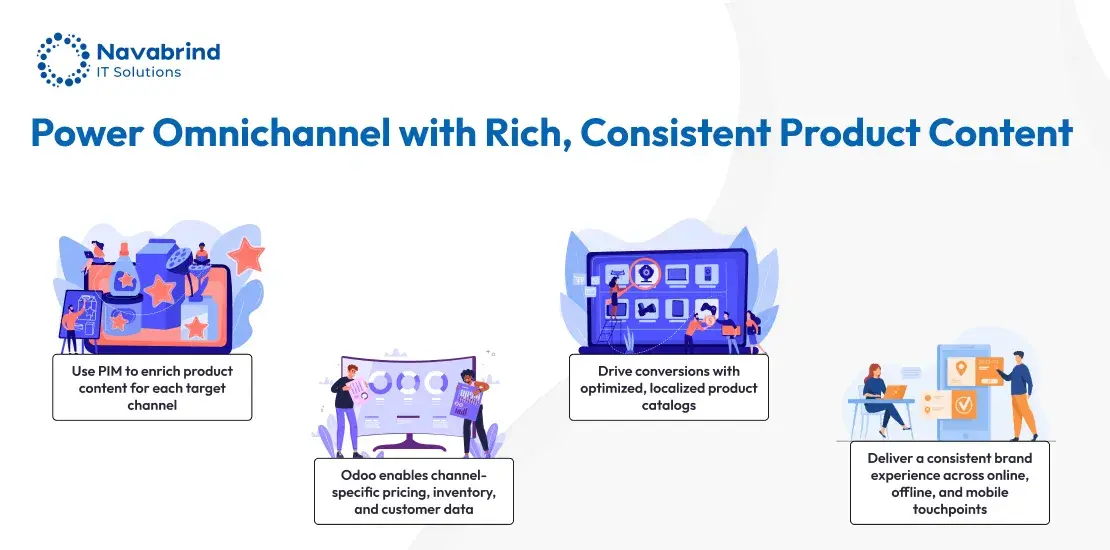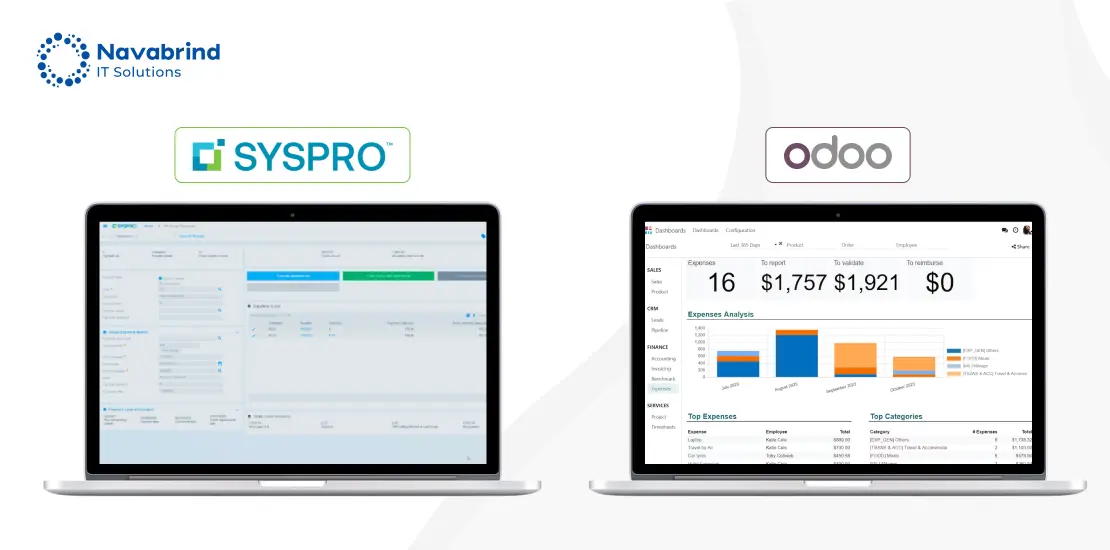How PIM Integration with Odoo Simplifies Product Data Management
- June 18, 2025
- Posted by: Tony
- Categories: Blog, PIM

Product data chaos costs businesses an average of 25% of their annual revenue through the dissemination of wrong information, constant rework, missed sales opportunities and inefficient operations. However, forward-thinking companies are solving this challenge by implementing a PIM Odoo integration.
In fact, businesses that have integrated Product Information Management (PIM) with their Odoo systems report up to 40% faster product launches and 60% reduced data entry errors. These impressive results stem from centralized data management and streamlined product information workflows.
Understanding a PIM Odoo Integration
The global PIM market is experiencing unprecedented growth, projected to reach USD 59.25 billion by 2027, growing at a remarkable CAGR of 25.2% from 2020 to 2027. This surge reflects the fundamental transformation in how businesses manage and utilize product information.
Evolution of PIM solutions
The journey of PIM solutions has shifted dramatically from basic spreadsheets and databases to sophisticated, cloud-based systems. Notably, businesses previously struggled with data silos, where 47% of marketers reported their data was difficult to access and scattered across systems. The challenge of managing large quantities of data generated daily has pushed organizations to seek robust solutions.
Why PIM Odoo integration matters now more than ever
Streamlined product data with Odoo has become crucial as modern commerce demands seamless data flow across channels. Research shows that 72% of consumers check prices and 52% review detailed product descriptions before making purchases. Poor product data management directly impacts business performance, with 40% of consumers returning online purchases due to inaccurate product content.
Key features of modern PIM systems
Modern PIM solutions offer sophisticated capabilities essential for today’s digital commerce:
- Data Centralization: Cloud-based systems enable unified product information access, reducing data silos and promoting standardization.
- Intelligent Automation: AI-powered tools handle data entry and validation, significantly improving accuracy and efficiency.
- Multichannel Support: Systems now manage product information across various platforms, with businesses seeing up to 30% increase in sales through effective omnichannel presence.
- Advanced Analytics: Organizations investing in data management (65%) and data governance (63%) benefit from real-time insights and performance tracking.
The shift toward cloud-based PIM solutions has been significant, with 60% of merchants reporting greater scalability and flexibility through these systems. Businesses can now manage complex product catalogs and streamline product data with PIM Odoo integration.
Measurable Benefits of PIM Odoo Integration
Businesses implementing PIM Odoo integration report substantial improvements across multiple performance indicators. Recent studies reveal compelling evidence of the transformative impact on operations and bottom-line results.
Revenue impact and ROI statistics
Organizations utilizing product data management with Odoo experience remarkable financial gains. Sales conversion rates increase by 15-20% through enhanced product data quality and improved search engine rankings. Moreover, companies report revenue increases attributed to faster time-to-market capabilities.
The return on investment manifests through reduced operational costs and increased sales efficiency. Businesses achieve a 2x higher sales growth compared to competitors over a two-year period after implementing PIM solutions. Essentially, the combination of improved data accuracy and streamlined processes directly contributes to revenue enhancement.
Efficiency improvements in numbers
Time management metrics showcase dramatic improvements in operational efficiency. Teams save over 50% of time previously spent on product data management tasks. Accordingly, this translates to approximately 1,666 hours saved annually for businesses managing 1,000 products across five sales channels.
Product launch cycles see notable acceleration, with companies reporting 30% faster time-to-market for new products. Streamlining product data with an PIM Odoo integration enables organizations to handle 100% more SKUs without requiring additional staff.
Customer satisfaction metrics
Customer experience metrics demonstrate significant positive outcomes from PIM Odoo integration. Return rates decrease by 40-50% due to accurate and detailed product information. This reduction stems from customers making better-informed purchase decisions based on comprehensive product data.
The implementation of PIM solutions leads to a 25% increase in customer retention rates. This improvement results from consistent and accurate product information across all channels, building trust and enhancing the overall shopping experience.
Real-World Success Stories of PIM Odoo Integration
A successful PIM Odoo integration demonstrates remarkable transformations across businesses of all sizes. Let’s examine how different organizations achieved substantial improvements through strategic implementation.
Case study: Small business transformation
Initially struggling with spreadsheet-based management, Leigh Country’s journey showcases the power of PIM Odoo integration for smaller enterprises. The company reduced their product launch time from two weeks to just minutes. Subsequently, their streamlined operations led to a 99-hour monthly time savings in product data management. The implementation also resulted in a swift return on investment within 12 months.
Case study: Enterprise-level results
Large-scale implementations likewise yield impressive outcomes. A heavy equipment manufacturer successfully consolidated data for 2 million products from 30 legacy systems into a unified PIM repository. This integration improved their time-to-market by 15x and achieved 95% data accuracy.
Another noteworthy example is Musco Food, which managed to streamline operations for their fluctuating inventory of 1,700 active products. Their sales representatives now access real-time product information through e-catalogs, eliminating the need for constant PDF updates.
Key success factors from implementations
Analysis of successful PIM-Odoo integrations reveals several critical elements that drive positive outcomes:
- Data Quality Focus
- Automated data cleansing processes
- Standardized product information workflows
- Regular data accuracy audits
The most successful implementations prioritize proper planning and stakeholder communication. For instance, Baldinini achieved significant efficiency gains by ensuring all departments, from marketing to customer service, were aligned with the new system.
Organizations that excel in PIM implementation certainly emphasize comprehensive training and support. Indeed, companies report that providing detailed documentation and continuous learning resources results in higher user adoption rates.
A supermarket chain undoubtedly demonstrated the impact of proper implementation by increasing their eCommerce orders by 30% annually after PIM integration. Their success stemmed from prioritizing data governance and establishing clear workflows from the start.
These real-world examples underscore that successful PIM Odoo integration requires a balanced approach combining technical expertise with strategic planning. The results consistently show improved operational efficiency, enhanced data accuracy, and stronger market performance across various business sizes and industries.

Streamline product data with Odoo PIM integration
Successful PIM implementation requires meticulous planning and strategic execution. A structured approach ensures optimal integration while minimizing disruptions to existing operations.
Step-by-step integration roadmap
A comprehensive implementation strategy begins with thorough preparation. Businesses must conduct a detailed assessment of their current product data management processes and identify specific goals. This initial evaluation helps establish clear objectives and measurable outcomes.
The implementation process follows these critical stages:
- Data Assessment and Cleansing: Evaluate existing data quality and standardize formats
- System Configuration: Set up workflows, user roles, and validation rules
- Integration Setup: Configure APIs and establish connections with existing systems
- Testing and Validation: Verify data accuracy and system performance
- User Training: Provide comprehensive training and documentation
Common pitfalls and solutions
Organizations often encounter several challenges during PIM implementation. Data quality issues pose significant risks, with 78% of businesses reporting improved accuracy after addressing these concerns.
To overcome common obstacles, successful implementations focus on:
- Data Migration Complexity: Rather than attempting a complete migration at once, adopt a phased approach to ensure data integrity. This strategy has helped companies achieve up to 95% data accuracy rates.
- System Integration Issues: Establish clear integration protocols and utilize middleware solutions when necessary. Organizations that implement proper integration strategies report 40% faster deployment times.
- User Resistance: Combat this through comprehensive training programs and clear communication about benefits. Companies that invest in proper training see 85% higher user adoption rates.
Resource allocation best practices
Effective resource allocation proves crucial for implementation success. Organizations should dedicate specific teams to manage different aspects of the implementation process.
Key resource allocation strategies include:
- Dedicated Project Team: Assign skilled personnel to oversee the implementation process. Teams with dedicated resources report 60% fewer implementation delays.
- Stakeholder Involvement: Include representatives from all affected departments in the planning and execution phases. This approach has shown to reduce implementation time by 40%.
- Training Investment: Allocate sufficient resources for comprehensive training programs. Companies that invest in thorough training see a 50% reduction in post-implementation issues.
- Support Infrastructure: Establish ongoing support mechanisms, including help desk services and documentation resources. Organizations with robust support systems report 70% higher user satisfaction rates.
Future-Proofing Your PIM Odoo Integration
In the rapidly evolving digital commerce landscape, staying ahead requires a forward-thinking approach to PIM Odoo investments. Recent market analysis indicates that PIM solutions with AI capabilities will handle 65% of product data management tasks by 2025.
Emerging trends in PIM technology
The technological landscape of PIM is undergoing significant shifts. AI and machine learning are at the forefront, with automated data enrichment reducing manual efforts by up to 50%. Key emerging trends include:
- AI-Powered Automation: Natural Language Generation capabilities transform master data into rich, human-like descriptions at scale
- Blockchain Integration: Enhanced supply chain transparency and security through decentralized data validation
- Real-time Analytics: Advanced systems now provide instant insights into product performance and market trends
- Sustainability Tracking: Digital Product Passport implementation for environmental impact monitoring
Scalability considerations
Progressively, businesses must evaluate their PIM Odoo integration infrastructure’s ability to grow. Studies show that companies managing extensive catalogs require systems capable of handling 2.5 quintillion bytes of data daily.
A robust scalability framework encompasses several critical elements. First, data modeling flexibility allows businesses to adapt to changing market demands without technical bottlenecks. Second, multichannel capabilities enable seamless expansion across new platforms, with organizations reporting 30% faster market entry rates.
Cloud-based PIM solutions offer significant advantages for scaling operations. These platforms demonstrate 60% better performance in handling increased data volumes. Businesses must ensure their chosen solution provides:
- Automated Workflows: Systems capable of processing multiple product launches simultaneously
- Global Reach: Support for 250 ISO languages and regional compliance requirements
- Resource Optimization: Capability to manage increased workloads without proportional staff increases
Preparing for future integrations
Moving forward, successful PIM implementation requires strategic preparation for future technological advances. Organizations must establish flexible integration frameworks that support emerging technologies and market requirements.
Key preparation strategies include implementing API-first architectures, which enable 40% faster deployment of new integrations. Simultaneously, businesses should focus on developing modular systems that allow for seamless addition of new capabilities.
The integration roadmap should prioritize:
- Microservices Architecture: Enables independent scaling of different PIM components
- Cross-platform Compatibility: Ensures seamless data flow across new channels and marketplaces
- Advanced Security Protocols: Protects expanding data ecosystems while maintaining accessibility
Ultimately, future-proofing PIM investments requires a balanced approach between current needs and future capabilities. Companies that successfully implement these strategies report 200% higher adaptability to market changes and 40% faster response to new technological opportunities.
Frequently Asked Questions
1. What is PIM, and how does it integrate with Odoo?
Product Information Management (PIM) is a centralized platform used to manage and optimize all product-related information. It ensures that businesses maintain accurate, consistent, and enriched product data across various channels.
PIM Odoo integration acts as a bridge between the ERP system and external sales or marketing platforms. This integration enables seamless data flow, ensuring product information in Odoo is enriched and consistent.
- Streamline Product Data with Odoo PIM Integration: PIM organizes data such as product descriptions, attributes, images, and pricing in one place, which Odoo uses to populate its ERP modules.
- Centralized Data Management ERP: Integration ensures that data from PIM flows into Odoo’s inventory, sales, and e-commerce modules, eliminating duplication and improving data consistency.
- How to Integrate PIM with Odoo for Product Data: PIM systems like Akeneo or Pimcore can be connected to Odoo using APIs or connectors, ensuring real-time synchronization of product data.
2. Can PIM integration with Odoo support multi-channel sales?
Yes, PIM Odoo integration is a powerful solution for managing multi-channel sales by ensuring consistent product information across platforms such as e-commerce websites, marketplaces, and physical stores.
- Product Data Management with Odoo: PIM consolidates product information, while Odoo distributes this data seamlessly to various sales channels.
- Multi-Channel Synchronization: Integration allows businesses to update product details in PIM, which are automatically synced to all connected Odoo channels, ensuring consistency.
- Dynamic Attributes Management: PIM manages varying attributes (e.g., size, color, specifications) for different sales channels, ensuring accurate categorization in Odoo’s inventory and sales modules.
- Streamline Product Data with Odoo: By synchronizing data, businesses reduce time spent managing individual channel requirements and ensure up-to-date information everywhere.
This capability enhances the efficiency of managing multi-channel sales strategies, ensuring uniform branding and accurate data representation.
3. What are the benefits of PIM-Odoo integration for product data enrichment?
Integrating PIM with Odoo provides significant advantages in enriching and managing product data, making it a valuable asset for businesses handling large catalogs or complex product information.
- Centralized Data Management ERP: PIM centralizes product-related information, enabling businesses to manage and enrich data efficiently. This enriched data is automatically reflected in Odoo.
Enhanced Descriptions and Media: PIM allows for detailed product descriptions, high-quality images, and videos, which Odoo uses to improve e-commerce or marketing efforts. - Localized Content: Businesses can manage multi-language product data in PIM, which Odoo uses to support global operations seamlessly.
- Streamline Product Data with Odoo PIM Integration: By enriching product data in PIM, businesses can optimize searchability, categorization, and user engagement in Odoo-powered platforms.
4. Does Odoo PIM integration reduce manual data entry efforts?
Yes, Odoo PIM integration significantly reduces manual data entry, enhancing productivity and minimizing errors in product data management.
- Automated Data Synchronization: Changes made in PIM are automatically reflected in Odoo’s modules, eliminating the need for repetitive manual updates.
- Streamline Product Data Odoo: PIM organizes data in a structured format, which Odoo consumes to populate fields across inventory, sales, and e-commerce modules.
- Error Reduction: Automation minimizes the chances of human error, ensuring that product information remains accurate and consistent across all platforms.
- Time-Saving Workflow: Teams can focus on strategic tasks instead of spending hours on data entry, improving overall business efficiency.
This automation is a key benefit of using PIM with Odoo for data management, especially for businesses managing extensive product catalogs.
5. How does PIM integration with Odoo enhance the customer experience?
PIM Odoo integration improves the customer experience by ensuring that product information is accurate, detailed, and accessible across all customer touchpoints.
- Consistent Branding: With centralized data management ERP, businesses can maintain uniform product descriptions, images, and pricing across all sales channels.
- Localized Content Delivery: PIM supports multi-language product catalogs, enabling businesses to offer region-specific product information, improving customer satisfaction.
- Dynamic Data Updates: Any updates in product data are instantly reflected on e-commerce platforms and other channels powered by Odoo, ensuring customers always see the latest information.
- Customer Experience Boost Using PIM with Odoo: Rich, accurate product data enhances the online shopping experience, helping customers make informed purchase decisions.
By integrating PIM and Odoo, businesses can deliver a seamless and engaging experience, which is critical for customer retention and loyalty.
6. What types of product data can be managed through PIM integration with Odoo?
PIM integration with Odoo enables businesses to manage a wide range of product data effectively, making it an ideal solution for large or diverse product catalogs.
- Core Product Details: Names, SKUs, and categories are stored in PIM and synced with Odoo’s inventory and sales modules.
- Attributes and Variants: Dynamic attributes like color, size, or material are managed in PIM and reflected accurately in Odoo for better categorization and searchability.
- Media Content: High-quality images, videos, and technical documents are stored in PIM and used by Odoo for enhanced product listings.
- Localized Content: Multi-language descriptions and region-specific information are seamlessly integrated into Odoo to support global sales.
- Technical Specifications: Complex product data like dimensions, materials, or compliance information is centralized in PIM and distributed through Odoo’s modules.
This robust product data management capability exemplifies how PIM and Odoo handle complex product data efficiently, ensuring smooth operations and improved customer experiences.
Schedule a conversation with us now!
Related Articles
-
Post
Why US Manufacturers are Choosing Odoo Over Priority ERP
Why US Manufacturers are Choosing Odoo Over Priority ERP November 21, 2025 Posted by: Tony Categories: Blog, Odoo No Comments Are you a mid-sized US manufacturer feeling the squeeze? Does your sales team use one system, your shop floor runs on another, and your finance department is stuck manually reconciling it all in a third. -
Post
Why OdooPIM is the Perfect Combination for Omnichannel Product Strategy
Why OdooPIM is the Perfect Combination for Omnichannel Product Strategy November 19, 2025 Posted by: Sumit Sinha Category: odooPIM No Comments Modern retail customers need a smooth buying experience on every channel. Managing product details on multiple platforms can feel overwhelming, but a PIM omnichannel strategy provides a robust solution to this challenge. Product Information -
Post
Which ERP Fits Your Manufacturing Business Better in the USA: Odoo or SYSPRO?
Which ERP Fits Your Manufacturing Business Better in the USA: Odoo or SYSPRO? November 10, 2025 Posted by: Tony Categories: Blog, Syspro VS odoo No Comments From managing supply chains and production runs to handling complex inventory and compliance needs, Manufacturing ERP systems have become the foundation for growth and efficiency. Choosing the right ERP
How can we help you?
Get in touch with a solutions consultant that can share best practices and help solve specific challenges.









